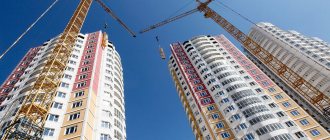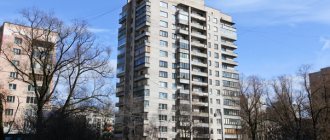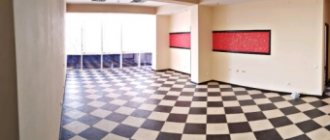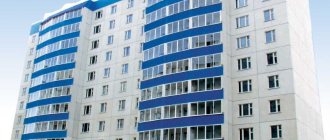The Town Planning Code and SNiPs make differences in the definitions of “number of storeys and number of floors”. What the difference is can be found in the regulatory documentation. Knowing the distinctive features of the main parameters in buildings, and not just the terminology, is necessary for a professional builder, an architect when developing projects, and a person who has to issue permits. Reveals the secret of how to determine the number of floors and the number of floors, what the difference is, and also explains well - the provision from the building codes and regulations 01/31/2003.
Features of construction terms
The building is a complex multifunctional system. Designers begin working on its construction long before the excavation work begins and the first brick or reinforced concrete wall is laid. Experts calculate the number of storeys and number of floors in a building; what they know is the difference is in the levels. Architects include in the design documentation:
- dimensions according to calculations of building elements;
- determine spaces and distances between different structures;
- calculate the loads on the floors and load-bearing beams.
The work is serious and painstaking; the safety of the future inhabitants of the buildings depends on it. This also applies to the number of storeys and number of floors. What is the difference is the space between the floor and ceiling surfaces. The created level between the floors, in which rooms are located, as well as structures above or below the ground, are all floors, and they require careful design.
Advantages and disadvantages of low-rise buildings
Low-rise buildings are developing at a rapid pace today, and their share in the total share of housing construction is constantly increasing. This is due to the following advantages of low-rise construction:
- minimum project approvals;
- high speed of construction;
- low cost of housing;
- environmental friendliness;
- low population density per square km;
- lower costs for organizing parking lots, recreation areas, playgrounds;
- low load on adjacent roads;
- comfort of stay.
The advantages of low-rise buildings also include autonomous infrastructure, aesthetics, ease of use and the possibility of constructing housing according to individual projects.
Low-rise construction also has disadvantages:
- High cost of land for construction.
- Difficulty in registering a plot of land.
- High cost of connecting communications.
The main feature of low-rise housing is increased living comfort, high speed and ease of cocking, environmental friendliness and affordable cost. The main disadvantage of a “low-rise” building is the high price of a land plot.
How to calculate the number of storeys?
The average person will have no doubt about determining the number of storeys and the number of floors of a building. It will count by visible windows, starting from the first and ending with the last. Builders classify their buildings, but in a slightly different way. The number of floors includes buildings:
- aboveground;
- technical;
- attic;
- basement structure, provided that its ceiling line is higher than 2 m from the ground.
All structures should be included in the floor count:
- basements;
- underground;
- basement;
- aboveground;
- technical;
- attic.
The urban planning classifier, by the number of floors, implies a certain criterion in order to conduct a state examination of the developed project, where the term number of floors is not used. It is to clarify expert data that the separation of concepts is important. Builders use it for different cases when they determine as much as possible:
- change the characteristics of the building;
- carry out reconstruction;
- carry out restoration.
Provided that the work is to be done in areas of historical buildings, and changes require part of the superstructures or extensions.
Building height
Buildings are classified according to different parameters. Designers identify components and structures, assembling them into a single system for experts or other inspectors. There are separate elements that foremen and direct performers need to pay attention to. Buildings are distinguished by the number of floors:
- 2 - small;
- 5 - average;
- 6 - high-rise buildings;
- 10 – elevated;
- 16 - high-rise buildings;
- from 20 and above - these include skyscrapers.
Buildings are assigned a height category:
- 50 m – 1;
- 75 m - 2;
- 100 m - 3;
- 101 m – 4.
High-rise buildings require special attention in ensuring their safety with a fire extinguishing system and smoke-free staircases; their presence is regulated by SNiPs. Such buildings have not really taken root here, except perhaps in central cities. But a mid-rise residential building can be found in every regional town.
Acceptance of rules
The local administration has the authority to adopt and make changes to the rules of development and land use with the established type of permitted use of sites.
It happens like this:
- Initially, the head prepares draft rules, creates a commission, develops phased urban zoning, sets deadlines for work and regulates the submission of comments and suggestions by persons whose interests it affects.
- After the decision is made, 10 days are allotted for posting information on the Internet and the media (mass media). The project must undergo a mandatory check to ensure there are no contradictions with the general plan and territorial planning scheme of the city or town.
- The prepared document is reviewed by the head of the municipality, if it does not contradict the norms governing this process, the latter, no later than 10 days, decides on the issue of public hearings, the maximum duration of which is 4 months, the minimum is 2, from the date the project is submitted for consideration.
- A development and land use project will not be legitimate without attaching the recorded result of public hearings. From the moment the approved rules are posted on the official platform of the authority on the Internet and in the media, individuals. and legal entities have the opportunity to challenge them in court.
State bodies The authorities of the Russian Federation and regions are vested with this right when the rules contradict the current regulatory framework or planning schemes for the territory of the state or its regions.
Typical characteristic
Each built-up level in the house has a clear description. Typical Features:
- Basement room - begins with a line of the floor area, which is located below ground level, but in height no more than half of the rooms located there.
- A basement is considered to be a marking on the floor surface after the ground line if the height corresponds to 1/2 of the premises.
- The underground floors of buildings are counted by the floor located below the ground level.
- Those located on the surface are all buildings whose floor plane is located above the level of the land line.
- The attics include the attic space, the façade of which consists of a roofing pie.
The technical part of the building includes areas where engineering equipment is located and laid communications are suitable. The technical floor is a unit and structural object with a special purpose; it can be placed underground or in the attic. Sometimes designers make choices in the most life-sustaining and unexpected places, such as in the middle of the house.
What other requirements apply to houses under individual housing construction?
In the Town Planning Code, the definition of the concept of an individual housing construction object (IHC) includes buildings with residential and auxiliary premises that are necessary for the full functioning and life of a person in the house (clause 3, article 48).
If the cottage meets the above parameters and has no more than 3 floors, then you will not have to create design documentation for it, even if you decide to renovate, reconstruct or overhaul it.
Geometric content
Regardless of what kind of residential building they built, the average number of floors, a larger or smaller parameter, previously professionals geometrically calculated the height of each space between horizontal surfaces. The design is carried out according to vertical distances, measured from the floor line of the lower floor to the upper one. The typical size of this parameter is allowed up to 2.7 m room height.
According to modern layouts, it does not always comply with usual standards. They carry out all the necessary calculations and make high lobbies that exceed the level of ordinary premises. Developers or owners treat residential space differently. It is not uncommon to find a residential basement. It was originally distributed and equipped this way by developers, or citizens moved in and reconstructed the building themselves.
What spaces are not counted?
When the design and construction of an apartment building or public building or structure takes place, the following are not included in the calculation of above-ground buildings in the form of floors:
- subfloor under the living space, regardless of height dimensions;
- the space between floors, if it is less than 1.8 m high;
- roof superstructures, areas leading from the staircase, elevator machine room, ventilation chamber, boiler rooms on the roofs.
Buildings are filled with structural elements such as variable floors. In technical plans, when they begin to develop documentation for houses with different numbers of floors, they are not listed, but the minimum and maximum (1-16) are indicated.
If an inventory of housing is carried out when there are separate parts of the house with different numbers of above-ground buildings, the floors are determined by the lowest value, actual and recorded in the technical plan. When designing an apartment building with a breakdown of the house plan on a slope with a basement, the slope increases the number of tiers; they are counted in parts in each individual section of the building.
Types of multi-storey buildings; choosing a building when buying an apartment
In the vast majority of cases, city residents prefer apartments due to the presence of a full range of advantages: heating, water, gas, electricity, sewerage, garbage collection, telephone, Internet, television.
Modern apartments are truly comfortable places to live, but it should be noted that this only happens as a result of the right choice of such housing.
And today we will look at the main aspects of this difficult process.
The main risks when buying an apartment in a new building
Buying an apartment on the secondary market can promise a lot of troubles in the foreseeable future. It is quite possible that in a few years the high-rise building may be demolished due to its disrepair. However, this point is typical only for the largest cities.
In the rest of Russia, the process of relocating people from dilapidated housing is not as active.
Of course, in this case there is no threat of a long and complicated relocation process, but the prospect of living in a crumbling house (and the technical condition of some of them is such that they are literally falling apart) is no better.
The purchase of houses in new buildings usually occurs both in the case of a ready-made house, where prices are very high, and at the stage of buildings that are just being constructed. The latter is called shared construction and provides the opportunity to purchase treasured square meters at the best price.
However, there are still many risks involved, and thousands of deceived shareholders will not let you lie. Therefore, before deciding to invest in a particular project, it is recommended to conduct analytical work. It consists of the following:
- A careful study of the developer himself. Fame, time on the market, positive and negative reviews, and the fact of being involved in scandals are important. Information about the construction company must be comprehensive. You must know the director, contact numbers, office address, and the like. If any of this causes concern, it is better to trust your intuition;
- The project declaration, accreditation of the developer in credit institutions, information about the future object, transaction methodology and the degree of responsibility of the contractor are analyzed;
- It is advisable to find out everything about the type of materials used, to identify the degree of their environmental and radiation safety.
Important! Sources of information are: the official website, which should not cause any complaints, specialized forums. In addition, the speed of construction is important. A monolithic house grows by 1-2.5 floors per month, and a panel house grows by 3-5 floors. If construction is slow, there may be problems.
Specialized residential buildings
The number of floors of buildings largely depends on their purpose. Buildings can be mass-produced or specialized. The first buildings contain apartments where families of different composition and economic status will live. Specialized houses according to their purpose are:
- dormitories;
- hotels;
- boarding schools for the disabled and elderly.
Each building is planned to accommodate people of varying durations. What height to build a house depends on regional authorities, construction legislation and its territorial location. Eg:
- large metropolitan areas are building up microdistricts with 9-story buildings;
- large cities place buildings in their residential areas, starting with five-module options;
- in small regional settlements and urban settlements, buildings with mid-rise buildings are typical;
- In villages, buildings are mostly built no higher than 2 floors.
Urban architecture is distinguished by its versatility and structural elements of different shapes.
Planning structure
Residential multi-apartment development has distinctive features in terms of volume and layout structure. Objects are divided by configuration:
- sectional;
- bellhop;
- gallery;
- blocked.
In buildings with sections, apartments are placed one above the other by floor, where they are connected:
- vertical communications;
- stairs;
- elevators.
The apartment has an entrance from the landing or elevator hall. In residential buildings, sections can be arranged either multiple or single. They satisfy owners differently in terms of efficiency, but allow developers to maneuver the placement of objects within the city, combining compositional solutions.
Features of corridor buildings
In gallery residential buildings, horizontal communications are equipped. The layouts are called corridor layouts due to the location of the apartments on the sides of this space. The system is connected by vertical communications, stairs and elevators. But it does not have proper cross-ventilation.
Therefore, in climate zones 3 and 4 categories, the corridor layout in houses was replaced by a gallery arrangement of apartments. In any case, their structure allows the efficient use of elevators, which makes it possible to increase the number of floors to 16.
Alteration
Changes may be considered for two reasons:
- A contradiction has been identified between the approved territorial planning schemes and the established rules for land use and development.
- Availability of an application to change the regulations on urban planning or the boundaries of territorial zones.
The authorities of the Russian Federation, constituent entities, and municipalities can make a proposal when the rules do not allow the placement of capital construction projects.
Then changes are made within a 30-day period, bypassing public hearings. We recommend that you read:
What does the town planning regulation define for a plot of land?
Individuals have the right to make such appeals. and legal entities, if the current rules do not allow the effective use of real estate built on the plot, or the price of the plots themselves decreases. Upon receipt of such an application, the commission draws up a conclusion within a month with recommendations to make the requested change or refuse it.
According to the document provided by the commission, the head of local government makes a decision, positive or negative. A mandatory condition will be to provide reasons for refusal. If the decision is positive, then the chapter has 30 days to prepare the project. The further procedure is the same as when adopting the rules.
Since land legislation has undergone changes, local governments have an obligation to take measures by 2021 to ensure that the type of permitted use of plots corresponds to the type of use specified in the classifier.
When a land owner makes such a request, a person with due authority is obliged to make a decision within a month; the copyright holder will be able, by presenting it, to change the information contained in the State Property Committee (GKN) (state real estate cadastre).
New time
The architecture of urban planning has changed noticeably compared to the Soviet period. They received apartments for free; it was enough to work at one enterprise for several years. Housing was developed and then built according to the same type of standard projects; it was no different even in different cities, except perhaps in the size of the areas. Now there are corridor and gallery sectional buildings. The spacious apartments occupy 2 floors with an internal staircase and corridors across one flight.
Household premises were distributed both below and above, this helps to use two types of communications - horizontal and vertical. These buildings are equipped with through ventilation from 2 sides. So far these are only experimental projects, they are not very actively taking root among the population. They cannot be called an economical or budget option, since it is impossible to accommodate less than 3 rooms in houses with a similar layout.
Let's tell you more details
Apartment layouts . The apartment layout of projects in MZhK differs significantly from the proposals for new multi-apartment buildings. Many layouts for low-rise housing construction are free. The owner himself determines the interior space of the apartment. Main trends: increasing the area of the kitchen and bathroom, reducing corridor areas, combining rooms.
Improvement . As mentioned above, the MZHK has implemented the concept of a “yard without cars”, special attention is paid to the creation of recreation areas for children and adults. The predominant placement of low-rise residential complexes on the outskirts of the city and in peripheral areas makes it possible to ensure close proximity to forested houses. Multi-level parking lots are being built for residential complexes with a large number of apartments. Due to the underground floors, it is possible to almost completely free the courtyards from cars.
Network engineering . Responsibilities for maintaining centralized MLC networks fall by default on the developer as the owner of the complex. The company implements one of 4 possible scenarios:
- transfers rights to utility networks to existing network or resource supply organizations under a purchase and sale agreement, under a joint investment contract, or by way of voluntary refusal;
- “abandons” property unilaterally (rarely), as a result of which ownerless networks appear, and the responsibility for organizing their further maintenance falls on the municipality;
- transfers the rights to a non-profit corporate organization specially created for the construction of the engineering infrastructure of the multi-residential complex under an investment contract;
- leaves the networks in the property, transferring them on a lease basis to a third-party company, which acts as a service provider to residents.
Interlocking housing construction
A blocking building can be multi-apartment, but have no more than 2 floors. It is allowed to locate one living space on two levels at once. Only the entrance to it is provided not from the corridors, but from the courtyard. These are convenient cottages for rural areas; near them you can plant a small vegetable garden or equip a walking yard. The land plot is located opposite the housing and is equal in width, resulting in up to 200 m2 for each owner. Block buildings accommodate up to 10 apartments from 3 to 5 rooms.
Approval of the rules
If the deadline determined by local laws is adopted, the PZZ must be posted on the website of the municipality and published in the media. At the same time, the legislator gives individuals and legal entities the opportunity to challenge the provisions of the document in court. Moreover, when the rules contradict regulations, as well as territorial planning schemes for the territory of the Russian Federation, approved before the adoption of the rules, the authorized state authorities of the Russian Federation and constituent entities of the Russian Federation have the right to challenge the decision to adopt them at the federal level.
Student housing
The hostels are still popular among students and working youth. For single people, they save their budget for temporary living and allow them to save money to buy a more comfortable home. Small films have been developed for families. This is a smaller copy of an apartment with 1 or 2 rooms, a bathroom and a toilet. Hotel-type buildings are supposed to receive clients for several days. In cities, such premises are not designed for special loads; they are placed in multi-storey buildings. Although the height of the building is ordered by the developer. He assumes the number of business travelers and tourists he plans to receive.
In many ways, the number of floors and comfort inside buildings and around houses depends on material support. The more buyers there are, the faster the construction industry develops. The number of floors is also influenced by customer demand. Not everyone likes to live in a high-rise and have to take an elevator to get to their apartment. The opportunity to settle down in a city with the conditions of a modern rural resident is attractive to many, but not everyone has the means to afford it.
Meanwhile, apartments in 5-story buildings are in demand and quickly find their owners. Therefore, developers outside the city are buying up land and building convenient, comfortable houses. But before construction work begins, design documentation is prepared for them, taking into account the floors. The administration gives permission to develop the site if experts make a positive conclusion regarding the structure of the land.
Composition and type of territorial zones, their boundaries
Development and land use rules regulate both the use and modification of capital construction projects. This is an urban zoning document, developed in order to implement the general plan of Moscow to determine the boundaries of territorial zones and establish urban planning regulations in relation to them.
The establishment of boundaries of territorial zones is carried out taking into account:
- the possibility of combining different types of existing and planned land uses within one territorial zone;
- territorial zones that are determined by the current Code;
- functional zones and indicators of their future development, established in accordance with the general plan of the settlement;
- boundaries of lands of various categories subject to change;
- actual land use and existing layout of the territory;
- impossibility of causing damage to capital facilities located on adjacent plots of land;
- historical and cultural plan of a historical settlement of federal and regional significance.
Borders can go along:
- lines of streets, driveways, highways of traffic flows moving in the opposite direction;
- red lines;
- the boundaries of cities and towns, as well as the land plots themselves;
- natural contours of monuments, natural objects;
- other objects.
The boundaries of zones established in accordance with the legislation of the Russian Federation, for which special conditions for the use of territories are determined, may differ from the boundaries of zones of the territory.
During urban planning zoning, zones for public and business, production, industrial, agricultural purposes, residential zones, engineering infrastructure zones, military installation zones, special zones, etc. can be determined.
Any zone may include subzones, for example, residential zones include areas intended for:
- placement of individual housing construction objects;
- construction of low-, medium- and high-rise buildings;
- construction of other types of residential buildings.
Do you need a building permit for a mid-rise residential development planned in the capital? We are ready to take an active part in the design, construction and registration of the facility, so if you do not know where to start and how to successfully go all the way, from receiving the document to putting the finished building into operation, we recommend calling us.









